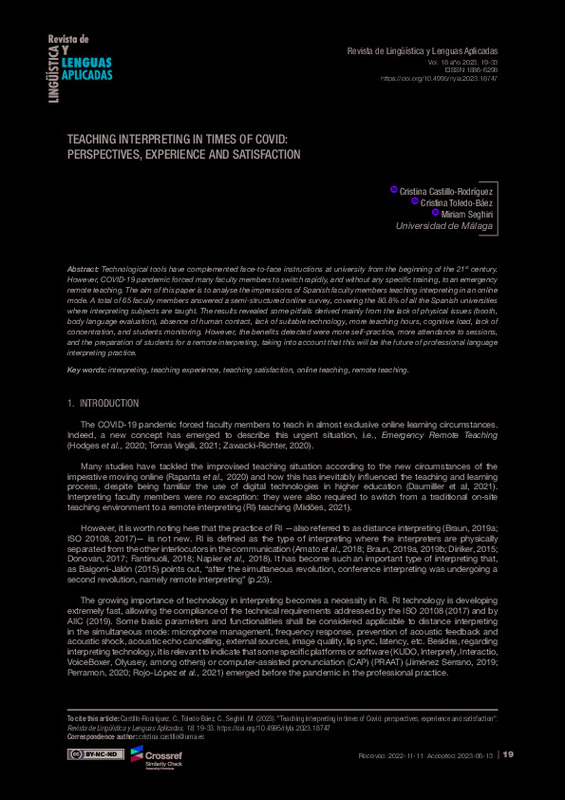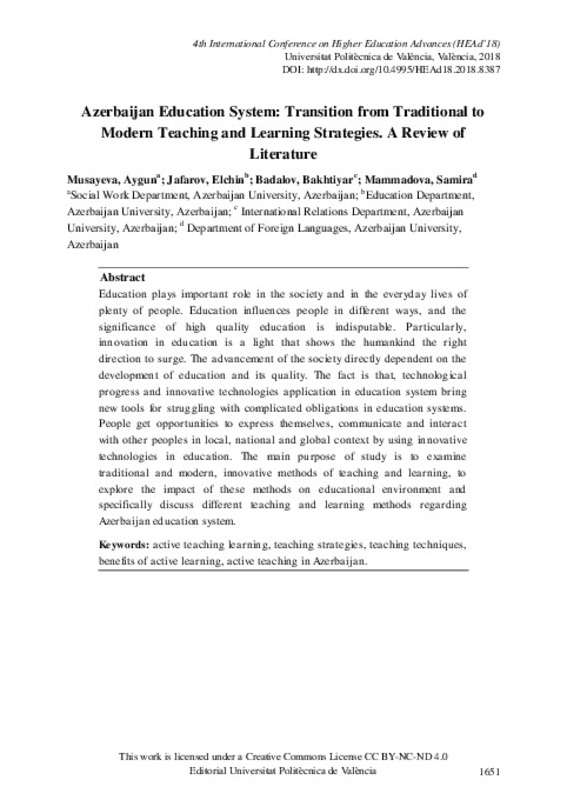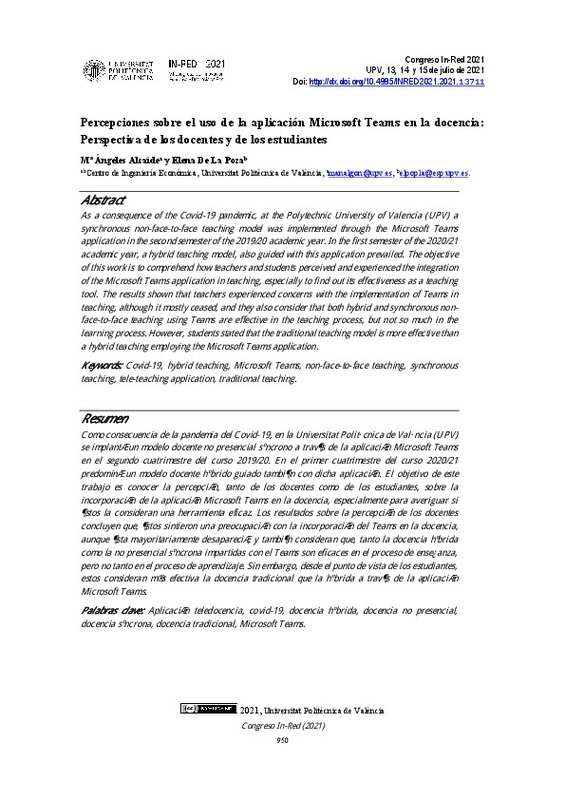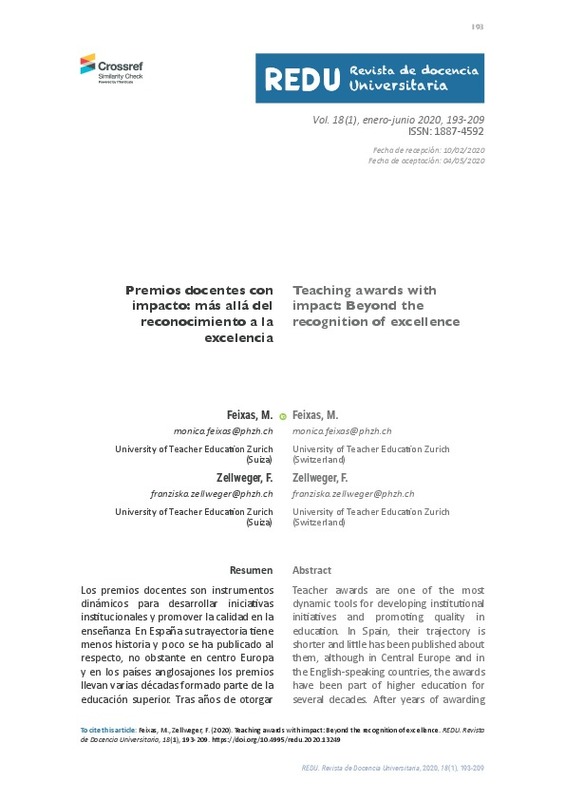JavaScript is disabled for your browser. Some features of this site may not work without it.
Buscar en RiuNet
Listar
Mi cuenta
Estadísticas
Ayuda RiuNet
Admin. UPV
Teaching interpreting in times of Covid: perspectives, experience and satisfaction
Mostrar el registro sencillo del ítem
Ficheros en el ítem
| dc.contributor.author | Castillo-Rodríguez, Cristina
|
es_ES |
| dc.contributor.author | Toledo-Báez, Cristina
|
es_ES |
| dc.contributor.author | Seghiri, Miriam
|
es_ES |
| dc.date.accessioned | 2023-10-17T22:10:40Z | |
| dc.date.available | 2023-10-17T22:10:40Z | |
| dc.date.issued | 2023-07-26 | |
| dc.identifier.issn | 1886-2438 | |
| dc.identifier.uri | http://hdl.handle.net/10251/198262 | |
| dc.description.abstract | [EN] Technological tools have complemented face-to-face instructions at university from the beginning of the 21st century. However, COVID-19 pandemic forced many faculty members to switch rapidly, and without any specific training, to an emergency remote teaching. The aim of this paper is to analyse the impressions of Spanish faculty members teaching interpreting in an online mode. A total of 65 faculty members answered a semi-structured online survey, covering the 80.8% of all the Spanish universities where interpreting subjects are taught. The results revealed some pitfalls derived mainly from the lack of physical issues (booth, body language evaluation), absence of human contact, lack of suitable technology, more teaching hours, cognitive load, lack of concentration, and students monitoring. However, the benefits detected were more self-practice, more attendance to sessions, and the preparation of students for a remote interpreting, taking into account that this will be the future of professional language interpreting practice. | es_ES |
| dc.description.abstract | [ES] [Las herramientas tecnológicas han complementado la enseñanza presencial en la universidad desde principios del siglo XXI. Sin embargo, la pandemia COVID-19 obligó a muchos profesores a cambiar rápidamente, y sin formación específica, a una enseñanza a distancia de emergencia. El objetivo de este artículo es analizar las impresiones de los profesores españoles que imparten clases de interpretación en línea. Un total de 65 profesores respondieron a una encuesta semiestructurada en línea, que cubría el 80,8% de todas las universidades españolas en las que se imparten asignaturas de interpretación. Los resultados revelaron algunos escollos derivados principalmente de la falta de cuestiones físicas (cabina, evaluación del lenguaje corporal), la ausencia de contacto humano, la falta de tecnología adecuada, el mayor número de horas lectivas, la carga cognitiva, la falta de concentración y el seguimiento de los estudiantes. Sin embargo, los beneficios detectados fueron más autopráctica, más asistencia a las sesiones y la preparación de los alumnos para una interpretación a distancia, teniendo en cuenta que éste será el futuro de la práctica profesional de la interpretación de idiomas. | es_ES |
| dc.description.sponsorship | This study was partially carried out in the framework of the projects e-Phone4Life (AEI) (ref. No. PID2019-105678RB-C21), NEUROTRAD (ref. No. B1-2020_07), INMOCOR (ref. No. P20-00109). Instituto Universitario de Investigación de Tecnologías Lingüísticas Multilingües (IUITILM). | es_ES |
| dc.language | Inglés | es_ES |
| dc.publisher | Universitat Politècnica de València | es_ES |
| dc.relation.ispartof | Revista de Lingüística y Lenguas Aplicadas | es_ES |
| dc.rights | Reconocimiento - No comercial - Sin obra derivada (by-nc-nd) | es_ES |
| dc.subject | Interpretación de idiomas | es_ES |
| dc.subject | Experiencia docente | es_ES |
| dc.subject | Satisfacción docente | es_ES |
| dc.subject | Enseñanza en línea | es_ES |
| dc.subject | Enseñanza a distancia | es_ES |
| dc.subject | Teaching experience | es_ES |
| dc.subject | Teaching satisfaction | es_ES |
| dc.subject | Online teaching | es_ES |
| dc.subject | Remote teaching | es_ES |
| dc.subject | Language Interpretation | es_ES |
| dc.title | Teaching interpreting in times of Covid: perspectives, experience and satisfaction | es_ES |
| dc.type | Artículo | es_ES |
| dc.identifier.doi | 10.4995/rlyla.2023.18747 | |
| dc.relation.projectID | info:eu-repo/grantAgreement/Junta de Andalucía//P20-00109/ES/Compilación de un macrocorpus para la generación de recursos multilingües en el ámbito inmobiliario (español-inglés/francés/italiano)/INMOCOR | es_ES |
| dc.relation.projectID | info:eu-repo/grantAgreement/MICINN//PID2019-105678RB-C21/ES/E-learning phonetics for life: English pronunciation in digital environments for Spanish and Galician speaking learners/e-Phone4Life | es_ES |
| dc.relation.projectID | info:eu-repo/grantAgreement/UMA//B1-2020_07/ES/Neural machine translation and human-machine parity: evaluation and post-editing aspects/NEUROTRAD | es_ES |
| dc.rights.accessRights | Abierto | es_ES |
| dc.description.bibliographicCitation | Castillo-Rodríguez, C.; Toledo-Báez, C.; Seghiri, M. (2023). Teaching interpreting in times of Covid: perspectives, experience and satisfaction. Revista de Lingüística y Lenguas Aplicadas. 18:19-33. https://doi.org/10.4995/rlyla.2023.18747 | es_ES |
| dc.description.accrualMethod | OJS | es_ES |
| dc.relation.publisherversion | https://doi.org/10.4995/rlyla.2023.18747 | es_ES |
| dc.description.upvformatpinicio | 19 | es_ES |
| dc.description.upvformatpfin | 33 | es_ES |
| dc.type.version | info:eu-repo/semantics/publishedVersion | es_ES |
| dc.description.volume | 18 | es_ES |
| dc.identifier.eissn | 1886-6298 | |
| dc.relation.pasarela | OJS\18747 | es_ES |
| dc.contributor.funder | Junta de Andalucía | es_ES |
| dc.contributor.funder | Ministerio de Ciencia, Innovación y Universidades | es_ES |
| dc.contributor.funder | Universidad de Málaga | es_ES |
| dc.description.references | Afolabi, S. & Oyetoyan, O.I. (2021). "Charting a new course for translator and interpreter training in Africa: lessons from the COVID-19 experience in selected countries", Jostrans 36b, 327-350. https://jostrans.org/issue36/art_afolabi.pdf | es_ES |
| dc.description.references | Ahrens, B. (2005). "Prosodic phenomena in simultaneous interpreting: a conceptual approach and its practical application", Interpreting 7/1, 51-76. https://doi.org/10.1075/intp.7.1.04ahr | es_ES |
| dc.description.references | Ahrens, B., Beaton-Thome, M. & Rütten, A. (2021). "The pivot to remote online teaching on the MA in Conference Interpreting in Cologne: lessons earned from an unexpected experience", Jostrans 36b, 251-284. https://jostrans.org/issue36/art_ahrens.pdf | es_ES |
| dc.description.references | AIIC (2019). AIIC Guidelines for distance interpreting (Version 1.0), January 11, 2019. https://aiic.org/document/4418/AIIC%20Guidelines%20for%20Distance%20Interpreting%20(Version%201.0)%20-%20ENG.pdf | es_ES |
| dc.description.references | Al-Salman, S. & Haider, A.S. (2021). "Jordanian university students' views on emergency online learning during COVID-19", Online learning 251, 286-302. https://doi.org/10.24059/olj.v25i1.2470 | es_ES |
| dc.description.references | Amato, A., Spinolo, N., & González Rodríguez, M.J. (eds.). (2018). Handbook of Remote Interpreting. SHIFT in Orality. University of Bologna. http://doi.org/10.6092/unibo/amsacta/595 | es_ES |
| dc.description.references | Ávila-Muñoz, A.M., Santos-Díaz, I.C. & Trigo-Ibáñez, E. (2020). "Análisis léxico-cognitivo de la influencia de los medios de comunicación en las percepciones de universitarios españoles ante la COVID-19", Círculo de Lingüística Aplicada a la Comunicación 84, 85-95. https://doi.org/10.5209/clac.70701 | es_ES |
| dc.description.references | Baigorri-Jalón, J. (2015). "The history of the interpreting profession", in H. Mikkelson & R. Jourdenais (eds.) The Routledge Handbook of Interpreting. London: Routledge, 11-28. | es_ES |
| dc.description.references | Braun, S. (2019a). "Technology and Interpreting", in M. O'Hagan (ed.) Routledge Handbook of Translation and Technology. London: Routledge, 352-367. https://doi.org/10.4324/9781315311258-16 | es_ES |
| dc.description.references | Braun, S. (2019b). "Technology, Interpreting", in M. Baker & G. Saldanha (eds.) Routledge Encyclopedia of Translation Studies. London: Routledge, 569-574. https://doi.org/10.4324/9781315678627-121 | es_ES |
| dc.description.references | Cases Silverstone, M. (2020). Guía orientativa: la interpretación simultánea remota. AICE (Asociación de Intérpretes de Conferencia en España. https://www.aice-interpretes.com/isremota/isremota-pdf-4478.pdf | es_ES |
| dc.description.references | Corpas Pastor, G. & Gaber, M. (2020). "Remote intepreting in public service settings: technology, perceptions", SKASE: Journal of Translation and Interpretation, 13/2, 58-78. http://www.skase.sk/Volumes/JTI19/pdf_doc/04.pdf | es_ES |
| dc.description.references | Cresswell, J. & Clark, V. P. (2018). Designing and conducting mixed methods research. Sage publications. | es_ES |
| dc.description.references | Daumiller, M., Rinas, R., Hein, J., Janke,S., Dickhäuser, O. & Dresel, M. (2021). "Shifting from face-to-face to online teaching during COVID-19: the role of university faculty achievement goals for attitudes towards this sudden change, and their rlevance for burnout/engagement and student evaluations of teaching quality", Computers in Human Behavior 118. https://doi.org/10.1016/j.chb.2020.106677 | es_ES |
| dc.description.references | Dave, K., Lawrence, S. and Pennock, D.M. (2003). "Mining the peanut gallery: Opinion extraction and semantic classification of product reviews", in Proceedings of the 12th international conference on World Wide Web, 519-528. https://doi.org/10.1145/775152.775226 | es_ES |
| dc.description.references | Diriker, E. (2015). "Conference Interpreting", in H. Mikkelson & R. Jourdenais (eds.) The Routledge Handbook of Interpreting. London: Routledge, 171-185. | es_ES |
| dc.description.references | Donovan, C. (2017). "The place of the Interpreter and interpreting in an institutional setting", CLINA 3/2, 91-113. https://doi.org/10.14201/clina20173291113 | es_ES |
| dc.description.references | Fantinuoli, C. (2018). Interpreting and Technology. Berlin: Language Science Press. | es_ES |
| dc.description.references | Fantinuoli, C. & Prandi, B. (2018). "Teaching information and communication technologies. A proposal for the interpreting classroom", Journal of Translation and Technical Communication Research 11/2, n.p. | es_ES |
| dc.description.references | Fouz-González, J. (2019). "Podcast-based pronunciation training: Enhancing FL learners' perception and production of fossilised segmental features", ReCALL 31/2, 150-169. https://doi.org/10.1017/S0958344018000174 | es_ES |
| dc.description.references | Gieshoff, A.C. (2018). The impact of audio-visual speech input on work-load in simultaneous interpreting. Mainz: Universität Mainz. | es_ES |
| dc.description.references | Gorjian, B., Hayati, A. & Pourkhoni, P. (2013). "Using Praat software in teaching prosodic features to EFL learners", Procedia - Social and Behavioural Sciences 84/9, 34-40. https://doi.org/10.1016/j.sbspro.2013.06.505 | es_ES |
| dc.description.references | Headley, M.G. & Clark, V.P. (2020). "Multilevel mixed methods research designs: Advancing a refined definition", Journal of mixed methods research 14/2, 145-163. https://doi.org/10.1177/1558689819844417 | es_ES |
| dc.description.references | Hodges, C., Moore, S., Lockee, B., Trust, T., & Bond, A. (2020). "The difference between emergency remote teaching and online learning", Educause Review, 27 March. https://er.educause.edu/articles/2020/3/the-difference-between-emergency-remote-teaching-and-online-learning | es_ES |
| dc.description.references | ISO 20108 (2017). Simultaneous interpreting - quality and transmission of sound and image input - requirements. Standard. International Organization for Standardization. | es_ES |
| dc.description.references | Jiménez-Serrano, O. (2019). "Interpreting Technologies. Introduction", Tradumàtica 17, 20-32. https://doi.org/10.5565/rev/tradumatica.240 | es_ES |
| dc.description.references | Le, H.T. & Brook, J. (2011). "Using Praat to teach intonation to ESL students", Hawaii Pacific University TESOL Working Paper Series 9/1,2, 2-15. https://www.hpu.edu/research-publications/tesol-working-papers/2011/9_1-2_Le%20Brook.pdf | es_ES |
| dc.description.references | Liu, B. (2010). "Handbook Chapter: Sentiment Analysis and Subjectivity", in N. Indurkhya & F.J. Damereu (eds.) Handbook of Natural Language Processing. Boca Raton: Chapman and Hall, 627-666. | es_ES |
| dc.description.references | Lord, G. (2008). "Podcasting communities and second language pronunciation", Foreign Language Annals 41/2, 364-379. https://doi.org/10.1111/j.1944-9720.2008.tb03297.x | es_ES |
| dc.description.references | McMillan, J.H. & Schumacher, S. (2006). Investigación educativa. Madrid: Pearson. | es_ES |
| dc.description.references | Mendoza, A. (2011). "La investigación en didáctica de las primeras lenguas", Educatio Siglo XXI 29/1, 31-80. | es_ES |
| dc.description.references | Midões, A. (2021). Adapting to Remote Interpreting Training in Times of COVID-19 - An Experimental Study. Porto: Polytechnic of Porto. | es_ES |
| dc.description.references | Mirek, J. (2021). "Teaching Simultaneous Interpreting during the COVID-19 pandemic: a cae study", New voices in translation studies 24, 94-103 | es_ES |
| dc.description.references | Napier, R., Skinner, S. & Braun, S. (eds). (2018). Here or there: research on interpreting via video link. Washington DC: Gallaudet. https://doi.org/10.2307/j.ctv2rh2bs3 | es_ES |
| dc.description.references | Nieto, P. & Alonso, L. (2008). "El podcasting como herramienta tecnológica aplicada a la docencia universitaria. Evaluación sobre una experiencia docente en interpretación consecutiva". V Congreso Iberoamericano de Docencia Universitaria. Enseñar y aprender en la universidad del siglo XXI: propuestas y condiciones. Universidad Politécnica de Valencia, 29-31 October 2008. | es_ES |
| dc.description.references | Osatananda, V. & Thinchan, W. (2021). "Using Praat for English Pronunciation Self-practice outside the classroom: strengths, weaknesses, and its application", LEARN Journal 14/2, 372-396. https://so04.tci-thaijo.org/index.php/LEARN/article/view/253273/171964 | es_ES |
| dc.description.references | Perramon, M. (2020). "COVID-19, interpretación remota y tecnología", Tradiling, https://www.tradiling.net/covid-19-interpretacion-remota-y-tecnologia/ | es_ES |
| dc.description.references | Qian, F. (2009). "Podcast in Interpreting Teaching", Journal of Hunan First Normal College 1, 129-131. http://caod.oriprobe.com/articles/15332713/Podcast_in_Interpreting_Teaching.htm | es_ES |
| dc.description.references | Pole, K. (2009). "Diseño de metodologías mixtas. Una revisión de las estrategias para combinar metodologías cuantitativas y cualitativas", Renglones 60, 37-42. https://rei.iteso.mx/handle/11117/252 | es_ES |
| dc.description.references | Rapanta, C., Botturi, L., Goodyear, P. , Guàrdia, L. and Koole, M. (2020). "Online university teaching during and after the Covid-19 crisis: refocusing teacher presence and learning activity", Postdigital Science and Education 2, 923-945. https://doi.org/10.1007/s42438-020-00155-y | es_ES |
| dc.description.references | Rojo-López, A., Foulquié-Rubio, A.I., Espín López, L. & Martínez-Sánchez, F. (2021). "Analysis of speech rhythm and heart rate as indicators of stress on student interpreters", Perspectives 29/4, 591-607. https://doi.org/10.1080/0907676X.2021.1900305 | es_ES |
| dc.description.references | Torrado Cespón, M. (2021). "TIC/TAC y COVID-19: uso y necesidades del profesorado de secundaria en Galicia", Digital Education Review 39, 356-373. https://doi.org/10.1344/der.2021.39.356-373 | es_ES |
| dc.description.references | Torras Virgili, M.E. (2021). "Emergency Remote Teaching: las TIC aplicadas a la educación durante el confinamiento por COVID-19", Innoeduca. International Journal of Technology and Educational Innovation 7/1, 122-136. https://doi.org/10.24310/innoeduca.2021.v7i1.9079 | es_ES |
| dc.description.references | Trigo Ibáñez, E., Rivera Jurado, P. & Sánchez Rodríguez, S. (2020). "La lectura en voz alta en la formación inicial de los maestros de Educación Infantil de la Universidad de Cádiz", Íkala, Revista de Lenguaje y Cultura 25/3, 605-624. https://doi.org/10.17533/udea.ikala.v25n03a07 | es_ES |
| dc.description.references | Vidyantari, R. (2021). "Online interpreting learning during pandemic from students' perspective", Bahtera: Jornal Pendidikan Bahasa dan Sastra 20/2, 210-215. http://journal.unj.ac.id/unj/index.php/bahtera/article/view/20329/10837 https://doi.org/10.21009/bahtera.202.07 | es_ES |
| dc.description.references | Yu, W. & van Heuven, V. (2017). "Predicting judged fluency of consecutive interpreting from acoustic measures. Potential for automatic assessment and pedagogic implications", Interpreting 19/1, 47-68. https://doi.org/10.1075/intp.19.1.03yu | es_ES |
| dc.description.references | Xhelili, P., Ibrahimi, E., Rruci, E. & Sheme, K. (2021). "Adaptation and perception of online learning during COVID-19 pandemic by Albanian university students", International Journal on Studies in Education 3/2, 103-111. https://doi.org/10.46328/ijonse.49 | es_ES |
| dc.description.references | Xu, M., Zhao, T. & Deng, J. (2021). "An empirical study on distance interpreter training in China before the COVID-19 pandemic: a mixed-methods approach", in C. Wang & B. Zheng (eds.) Empirical studies of translation and interpreting. The post-structuralist approach. New Yourk: Routledge, 259-279. https://doi.org/10.4324/9781003017400-19 | es_ES |
| dc.description.references | Wulansari, A., Fadhilia Arvianti, G. & Rekha, A. (2021). "Icatforlearning website for teaching", NOBEL: Journal of Literature and Language Teaching 12/1, 15-28. https://doi.org/10.15642/NOBEL.2021.12.1.15-28 | es_ES |
| dc.description.references | Zawacki-Richter, O. (2020). "The current state and impact of Covid-19 on digital higher education in Germany", Human Behaviour & Emerging Technologies 3, 218-226. https://doi.org/10.1002/hbe2.238 | es_ES |











